Access to and sustained use of improved household latrines have long been both a challenge as well as a policy priority in India, particularly in rural areas. Recognising the importance of social mechanisms that underlie household sanitation choices, this article utilises experimental public goods games in rural Bihar and Odisha, to examine how social factors, such as gender, influence preferences for improved sanitation.
Investments in health at the household level may be partly motivated by a sense of responsibility towards social peers. Can policies harness this motivation to encourage adoption and use of environmental health technologies such as household latrines? Can research identify and expand the definition of ‘social peers’ to aid policy implementation?
Access to and sustained use of improved household latrines have long been both a challenge as well as a policy priority in India, particularly in rural areas. National policies have succeeded in increasing latrine coverage across rural India (International Institute for Population Sciences, 2017). Yet, recent studies suggest that open defecation remains stubbornly persistent (Orgill-Meyer et al. 2019, Spears and Thorat 2019). What policy evaluations and academic studies agree on, however, is the likely role of social pressures on motivating household decisions to both invest in and use private latrines (Bell and Hueso 2013, Christakis 2015).
Recognising the importance of social mechanisms that underlie household sanitation choices, we examine how social factors, including gender, influence preferences for improved sanitation in rural Bihar and Odisha. We utilise experimental games to assess how preferences for collective action inform willingness to invest in improved household sanitation and hygiene options.
Why is collective action relevant to private sanitation choices?
Household sanitation behaviours represent private choices with public consequences. By investing in and using private latrines, households protect themselves from communicable diseases spread through human waste, such as diarrhoeal diseases (UNICEF and WHO, 2015). Latrines may also have non-health benefits to household members such as dignity, privacy, security, and status (Pattanayak et al. 2009). Yet, household members do not internalise all the benefits of investments in improved sanitation. By reducing their own exposure to communicable diseases, latrine-using households create a barrier to the spread of such illnesses (Pattanayak et al., 2018). Further, by switching away from open defecation, latrine-using households decrease the overall burden of faecal material in the public health environment. On the other hand, households that continue to practice open defecation enjoy public health benefits resulting from their neighbours’ investments in improved sanitation.
This scenario of interconnected sanitation behaviour risks – or benefits – was the crux of our experimental game intervention (Figure 1). The public goods-style games commenced with a short sanitation-related training session that focussed on the relationship between a household’s sanitation practices and the local public health environment.
Figure 1. Group of female participants being instructed by enumerators (left panel); Group of male participants making their sanitation contribution choices (right panel)
Following the training, groups of 5-7 participants engaged in the game-play rounds, in which they had the opportunity to earn real payoffs. In each round, they made a private contribution using a Rs.35 budget provided at the onset of each round. These private contributions, depicted in Figure 2, related to different sanitation and hygiene behaviours they could engage in, ranging from doing nothing (equivalent to a contribution of Rs. 0) to all household members using a private household latrine (equivalent to a contribution of Rs. 35).
Figure 2. Payment card used for indicating sanitation investment choices during experimental games
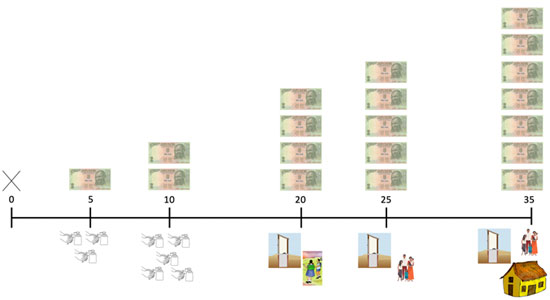
Note: In the figure, the valuations of payment cards indicate the following sanitation investment choices - Rs. 0: no sanitation/hygiene investment, Rs. 5: sometimes wash hands with soap, Rs. 10: always wash hands with soap, Rs. 20: ensure household children do not defecate in the open, Rs. 25: ensure all household members use public or neighbours’ latrine, Rs. 35 build and use a private household latrine.
After individual contributions were collected, the total group contribution was tallied and shared. In the spirit of a public goods game, if the total group contribution reached a pre-specified threshold – in our game, this was a contribution of Rs. 20 that reflected latrine use among household children – households received a bump-up to their payoff. This payoff increase was equally shared among all participants, regardless of individual contributions. In addition to this public payoff, participants received a small private return on their investment (in contrast to the public payoff, this private payoff varied according to individual contributions) as well as kept any of the initial budget they did not contribute to improving household sanitation. A total of nearly 300 experimental games were played with over 1,500 participants across 69 villages in Bihar and Odisha.
Does it matter who is in your group and, therefore, could benefit from the public effects of private sanitation choices?
Group composition was randomised at the onset of our project. In half of the games, groups were entirely male or entirely female and in the other half, groups were mixed gender. Gender was used as a measure of social connectedness, as, in the context of rural India, there is evidence for different decision-making power, levels of interaction, and sanitation preferences by gender (Khanna and Das 2016, Routray et al. 2017, Stopnitzky 2016). This random variation allows us to compare how group composition-affected sanitation contributions during each round of our experimental games.
Figure 3 depicts the share of groups that reached the contribution threshold required to unlock the public payoff bump-up, by group composition. In round one, we observe a significant difference in this share, with mixed-gender groups less likely to reach the public threshold compared to entirely male or entirely female groups. These differences remain – although decreased – in round 2. By round 3, they disappeared entirely. These trends suggest that participants playing among their same-gender peers are more willing to contribute to sanitation – a good with both private and public benefits. Yet, trust or cohesion within groups can increase quickly when it is apparent that group members are seeking a common goal.
Figure 3. Share of groups that reached the contribution threshold required to unlock public payoff bump-up, by group composition
Experiences may vary with gender
We find further evidence to suggest that the degree to which group composition matters may vary by gender. The left panel and right panel of Figure 4 compare the share of mixed-gender groups that reached the contribution threshold to the share of male-only groups (left panel) and the share of female-only groups (right panel). We see the wedge is driven entirely by female groups: women appear more likely to contribute at higher levels when playing among other women vis-à-vis mixed-gender settings. While this wedge decreases over game-play rounds, it is the increasing contributions in mixed-group games that makes up the difference.
Figure 4. Comparison of share of mixed-gender groups that reached contribution threshold to share of entirely male groups (left panel) and share of entirely female groups (right panel)
Targeting sanitation investments
Our findings have important implications for policymakers:
- Sanitation messaging may be more effective if it highlights benefits to neighbours and friends, along with private benefits. Group composition appeared to motivate sanitation investments early during game play. Utilising existing social structures in policy design may have returns in public health messaging.
- Yet, repetition strengthens group cohesion. One-shot interventions may be ineffective in generating sustainable behavioural change. Our games suggest that repetition in seeking common goals can create social links, which may motivate private investments with public dividends.
Rural communities face environmental and public health challenges that can only be addressed through collective commitment to health improvements at the household level. Experimental games, such as those implemented in the sanitation space in Bihar and Odisha as part of our study, can offer insight into how households form preferences for improved sanitation and how these preferences inform their sanitation investments over time.
Further Reading
- Hueso, Andrés and Brian Bell (2013), “An untold story of policy failure: the Total Sanitation Campaign in India”, Water Policy, 15 (6): 1001–1017.
- International Institute for Population Sciences (IIPS) and ICF (2017), ‘National Family Health Survey (NFHS-4), 2015-16: India’, Mumbai.
- Khanna, Tina and Madhumita Das (2016), “Why gender matters in the solution towards safe sanitation? Reflections from rural India”, Global Public Health, 11(10): 1185-1201.
- Orgill-Meyer, Jennifer, Subhrendu K Pattanayak, Namrata Chindarkar, Katherine L Dickinson, Upendra Panda, Shailesh Rai, Barendra Sahoo, Ashok Singha and Marc Jeuland (2019), “Long-term impact of a community-led sanitation campaign in India, 2005–2016”, Bulletin of the World Health Organization, 97(8): 523-533A.
- Pattanayak, SK, Emily L Pakhtigian, and Erin L Litzow (2018), ‘Through the Looking Glass: Environmental health economics in low and middle income countries’ in Dasgupta, P, SK Pattanayak and VK Smith (eds.), Handbook of Environmental Economics, Volume 4, 143-192, Elsevier, North Holland.
- Pattanayak, Subhrendu K, Jui-Chen Yang, Katherine L Dickinson, Christine Poulos, Sumeet R Patil, Ranjan K Mallick, Jonathan L Blitstein and Purujit Praharaj (2009), “Shame or subsidy revisited: social mobilization for sanitation in Orissa, India”, Bulletin of the World Health Organization, 87(8): 580–587.
- Routray, Parimita, Belen Torondel, Thomas Clasen and Wolf-Peter Schmidt (2017), “Women’s role in sanitation decision making in rural coastal Odisha, India”, PloS One, 12(5):e0178042.
- Shakya, Holly B, Nicholas A Christakis and James H Fowlera (2014), “Social network predictors of latrine ownership”, Social Science & Medicine, 125: 129-138.
- Spears, Dean and Amit Thorat (2019), “The Puzzle of Open Defecation in Rural India: Evidence from a Novel Measure of Caste Attitudes in a Nationally Representative Survey”, Economic Development and Cultural Change, 67(4): 725-755.
- Stopnitzky, Y (2016), ‘Changing preferences through experimental games: Evidence from sanitation and hygiene in Tamil Nadu’, Discussion Paper 1587, International Food Policy Research Institute.
- UNICEF and WHO (2015), ‘Progress on sanitation and drinking water – 2015 update and MDG assessment’, New York, US.




 08 January, 2021
08 January, 2021 





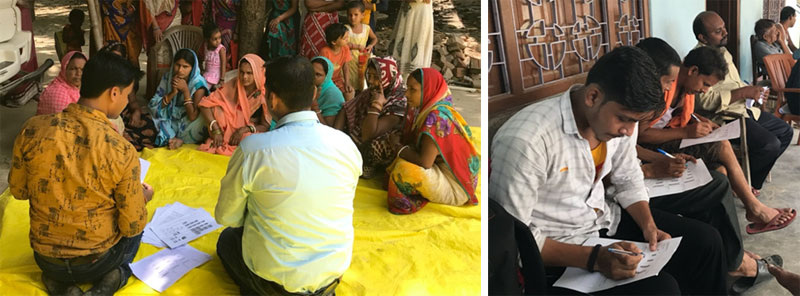
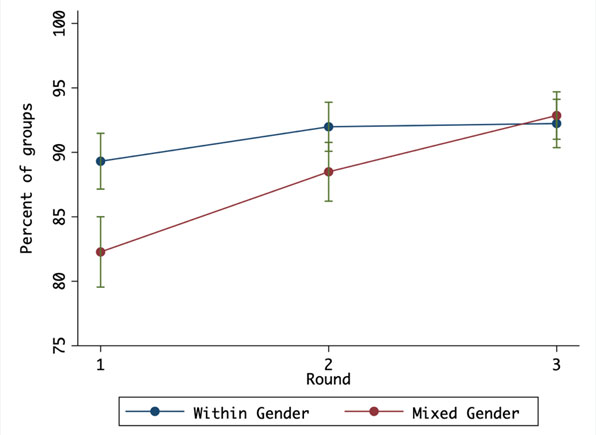
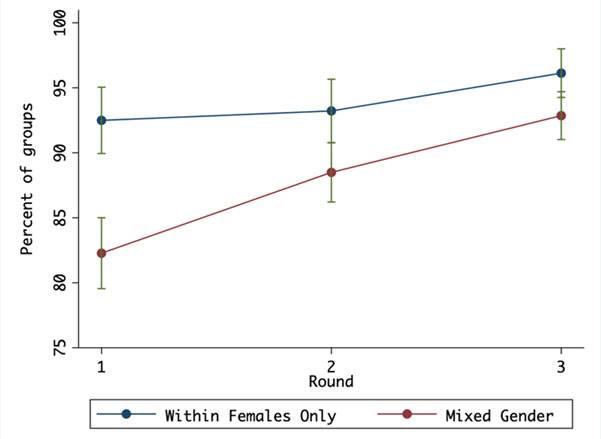
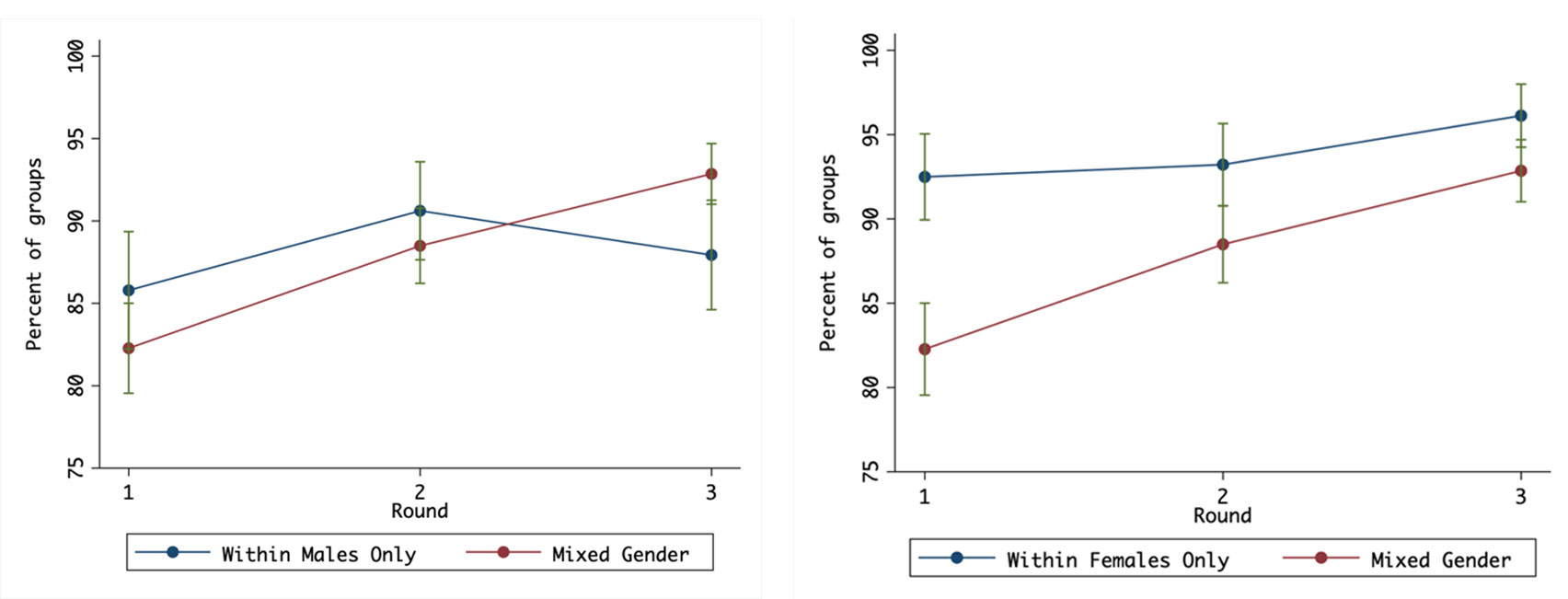
Comments will be held for moderation. Your contact information will not be made public.